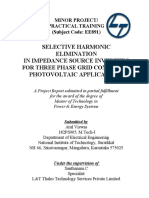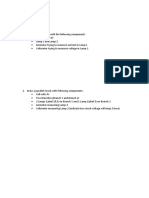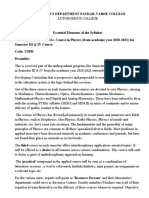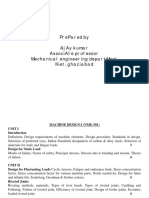Class XI Chem SAMPLE
Class XI Chem SAMPLE
Uploaded by
FIITJEE DPSCopyright:
Available Formats
Class XI Chem SAMPLE
Class XI Chem SAMPLE
Uploaded by
FIITJEE DPSOriginal Title
Copyright
Available Formats
Share this document
Did you find this document useful?
Is this content inappropriate?
Copyright:
Available Formats
Class XI Chem SAMPLE
Class XI Chem SAMPLE
Uploaded by
FIITJEE DPSCopyright:
Available Formats
PRE-BOARD EXAMINATION
CLASS XI
CHEMISTRY
TIME: 3 HOURS MM:70
General Instructions: Read the following instructions and strictly follow them.
Q1-Q5 are very short answer questions, 1 mark each.
Q6-12 are short answer questions, 2 marks each.
Q13-24 are short answer type questions, 3 marks each.
Q25-27 are long answers, 5 marks each.
Q1. Which oxide of N is isoelectronic with CO2-
a) NO2
b) NO
c) N2O
d) N2O3
Q2. Electronegativity of carbon atoms depends upon their state of
hybridisation. In which of the following compounds, the carbon marked with
asterisk is most electronegative?
a) CH3 – CH2 – *CH3 –CH3
b) CH3 – *CH = CH – CH3
c) CH3 – CH2 – C ≡ *CH
d) CH3 – CH2 – CH = *CH2
Q3. Which of the following statements is correct?
(a) The presence of reacting species in a covered beaker is an example of open system.
(b) There is an exchange of energy as well as matter between the system and the
surroundings in a closed system.
(c) The presence of reactants in a closed vessel made up of copper is an example of a closed
system.
(d) The presence of reactants in a thermos flask or any other closed insulated vessel is an
example of a closed system.
Q4. C-Cl bond of chlorobenzene in comparison to C-Cl
bond in methyl chloride is
a. Longer and weaker
b. Shorter and weaker
c. Shorter and stronger
d. Longer and stronger
Q5. Name the process associated with acylation of
benzene
a) Friedel craft reaction
b) Wurtz reaction
c) Wurtz fitting reaction
d) Debey Huckel reaction
Q6. (a) How many sub shells are associated with n=5?
(b) How many electrons will be present in these sub shell having ms value of -1/2 for n=4
Q7. Give one point to differentiate the following thermodynamic terms:
(a) Extensive properties and intensive properties.
(b) Isothermal process and isobaric process.
Q8. Classify, NH4+ and NH3 as Lewis acid or Lewis Base. Explain giving reasons.
Q9. (i) Write the general outer electronic configuration of f-block elements.
(ii) Assertion (A): All isotopes of a given element show the same type of chemical behaviour.
Reason (R): The chemical properties of an atom are controlled by the number of electrons in the
atom.
a) Both A and R are true and R is the correct explanation of A.
b) Both A and R are true but R is not the correct explanation of A.
c) A is true but R is false.
d) Both A and R are false.
Q10. (a) What type of isomerism is shown by pentane and 2-methylbutane ?
(b) Write the name of isomerism among the compounds : CH3—CH2—CHO and
Q11. Which of the following statements are not correct?
(i) NaCl being an ionic compound is a good conductor of electricity in the solid state
(ii) In canonical structures there is a difference in the arrangement of atoms
(iii) Hybrid orbitals form stronger bonds than pure orbitals
(iv) VSEPR Theory can explain the square planar geometry of XeF4
Q12. (a) How many Sigma and pi bonds are present in the following molecule
HC CCH =CHCH3
(b) In an estimation of sulphur by carius method 0.468 g of an organic compound gave
0.668 g of barium sulphate. Find the percentage of sulphur in the compound.
(at. Mass of S =32u, at. Mass of O=16u and at. Mass of Ba=137u)
Q13. Calculatetheconcentrationofnitricacidinmolesperlitreinasamplewhich has density 1.40 g mL–1 and
the mass percent of nitric acid in it being 69%. (Molar mass of HNO3 = 63 g mol–1)
Q14. Account for the following :
(a) An anion is always bigger than its parent atom.
(b) Chlorine has more negative electron gain enthalpy than fluorine.
[Given: Atomic No. F = 9, Cl = 17]
Q15. Give the shapes of following covalent molecules using VSEPR theory:
(a) CIF3 (b) XeF4 (c) AsF5
Q16. Compare the relative stability of the following species on the basis of
molecular orbital theory and indica their magnetic properties : O2+, O2–, O22–
Q17. The reactant which is entirely consumed in the reaction is known as a limiting reagent.
In the reaction 2A + 4B → 3C + 4D, when 5 moles of A react with 6 moles of B, then
(i) Which is the limiting reagent?
(ii) Calculate the amount of C formed?
Q18. (a) For the reaction, 2Cl(g) → Cl2(g), what are the signs of ∆H and ∆S ?
(b) Forthereactionat298K,2A+B→C, ∆H=400kJmol–1 and ∆S=0.2kJ K–1 mol–1. At what temperature will
the reaction becomes spontaneous ?
Q19. According to de Broglie, the matter should exhibit dual behaviour, that is, both particle and wave
like properties. However, a cricket ball of mass 100 g does not move like a wave when it is thrown by
a bowler at a speed of 100 km/h. Calculate the wavelength of the ball and explain why it does not
show wave nature.
Q20. a) A vessel contains 1.6 g of dioxygen at STP (273.15K, 1 atm pressure). The gas is now transferred
to another vessel at a constant temperature, where pressure becomes half of the original
pressure. Calculate
(i) volume of the new vessel.
(ii) number of molecules of dioxygen.
b) State the law of Multiple Proportions.
Q21. (a) Would you expect the first ionization enthalpies for two isotopes of the same element to be
the same or different? Justify your answer.
(b) Would you expect the second electron gain enthalpy of O as positive, more negative or less
negative than the first? Justify your answer.
(c) Arrange the elements of the second period in increasing order of their size. Explain.
Q22. (a) Write the IUPAC names of the following :
COOH
(b) Explain why (CH3 )3C+ is more stable than CH3C+H2.
Q23. (a) Identify the reagent shown underlined as electrophile or nucleophile :
CH3COOH + OH– → CH3COO– + H2O
(b) On complete combustion of 0.246 g of an organic compound gave 0.198g of CO2 and 0.1014 g
of H2O. Determine the percentage composition of carbon and hydrogen in the compound.
Q24. Complete the following reactions :
(a) CH3—CH=CH2 + HBr
(b) C2H5—Cl + Na dry ether
(c) alc. KOH,
Q25. (a)Write the electronic configuration of Cr (Z=24).Why is it different from the expected
configuration ?
(b) The mass of an electron is 9.1 × 10–31 kg and its kinetic energy is 3 × 10–25 J
Calculate its wavelength.
( c) Which of the following orbitals is not possible and why ?
2d, 2s, 3p, 3s
Q26. (a)Equilibrium constant of a reaction is 10. What will be the equilibrium constant for the
reverse reaction?
(b) Write the conjugate acids for the Bronsted base OH– and CH3COO–.
Equilibrium constant for a reaction is 10. What will be the equilibrium constant for the
reverse reaction?
(c) Determine the pH of 10–8 M HCl solution taking into account the H+ produced by water
also. (Given: log 11 = 1.0414)
Q27. a) Propanalandpentan-3-onearetheozonolysisproductofanalkene.What is the structural
formula of the alkene ?
b) Give the main products of the reactions :
(i) + CH3COCl
(ii)
(iii) Cl2 +
OR
1. An alkyl halide (A) of formula C6H13Cl on treatment with alcoholic KOH give two
isomeric alkenes (B) and (C) (C6H12). Both alkenes on hydrogenation give 2, 3-
Dimethylbutane. Predict the structure of A, B and C.
2. (b) Why does benzene show electrophilic substitution easily ?
3. (c) Name the compound that will be required to obtain butane using Kolbe’s electrolysis
process.
You might also like
- Chemistry Sample Papers Class XiDocument26 pagesChemistry Sample Papers Class Xijayanti obcNo ratings yet
- DefStd 61-12 (Part18)Document40 pagesDefStd 61-12 (Part18)darren100% (1)
- Math 112 Review Sheets - ANSWERSDocument5 pagesMath 112 Review Sheets - ANSWERSGarryNo ratings yet
- Exam Class XIDocument5 pagesExam Class XIFIITJEE DPSNo ratings yet
- Modified Xi Chem Hy QP PaperDocument6 pagesModified Xi Chem Hy QP PaperxdhustlesNo ratings yet
- Kvs Sample Paper Chemistry Page 2 - 6Document5 pagesKvs Sample Paper Chemistry Page 2 - 6Rohan BaghelNo ratings yet
- 11-Chemistry-A1-Annual Exam 2023-24Document8 pages11-Chemistry-A1-Annual Exam 2023-24harshitsharmasportsNo ratings yet
- Mtp-t2-Chemistry-11 2324Document4 pagesMtp-t2-Chemistry-11 2324Neeta RaniNo ratings yet
- Compartment 2 Chem QPDocument5 pagesCompartment 2 Chem QPAAKASH BHATTNo ratings yet
- Class 11Document3 pagesClass 11bikasonoinam321No ratings yet
- Class Xi Preparatory - ChemistryDocument20 pagesClass Xi Preparatory - Chemistrychashmak80No ratings yet
- Class 11 CHEMISTRY - Term2 Exam Question Paper (1) - 2020-21 2Document8 pagesClass 11 CHEMISTRY - Term2 Exam Question Paper (1) - 2020-21 2moiiifitbituserNo ratings yet
- Class 12 Chemistry Sample PaperDocument8 pagesClass 12 Chemistry Sample Paperabhinavdahiya77No ratings yet
- QP 3 Xi Chem Paper 3Document5 pagesQP 3 Xi Chem Paper 3technical SiteNo ratings yet
- 11che02 QPDocument5 pages11che02 QPPriyanshu BadhiaNo ratings yet
- SAMPLE PAPER - FinalTerm - GR11 - 2023-24Document8 pagesSAMPLE PAPER - FinalTerm - GR11 - 2023-24collect3.141No ratings yet
- QP_SE_XI_2023-24Document6 pagesQP_SE_XI_2023-24Tarun ChoudharyNo ratings yet
- 12 Chemistry Q.P.Document5 pages12 Chemistry Q.P.Aradhya SinghNo ratings yet
- QP Class Xi ChemDocument8 pagesQP Class Xi Chemingalemanisha852No ratings yet
- Sample Paper T-2, XI-Chem, 2021-22Document3 pagesSample Paper T-2, XI-Chem, 2021-22SushantNo ratings yet
- Class Xi(Chemistry)Document6 pagesClass Xi(Chemistry)savgunNo ratings yet
- Final G-11 Que PaperDocument8 pagesFinal G-11 Que PapercherrydevmNo ratings yet
- Chemistry Sample Paper 2023-2024 XiDocument6 pagesChemistry Sample Paper 2023-2024 XiRandom UserNo ratings yet
- Army Public School Dhaula Kuan Half Yearly Examination CHEMISTRY (2019)Document5 pagesArmy Public School Dhaula Kuan Half Yearly Examination CHEMISTRY (2019)YahooNo ratings yet
- Class Xia Set-1Document5 pagesClass Xia Set-1tanjiroyamado108No ratings yet
- Question Paper and Marking Scheme of ChemistryDocument10 pagesQuestion Paper and Marking Scheme of Chemistrytoyirtao7No ratings yet
- SAMPLE PAPER - FinalTerm - GR11 - 2023-24Document7 pagesSAMPLE PAPER - FinalTerm - GR11 - 2023-24rheaNo ratings yet
- Xi - ChemistryDocument4 pagesXi - Chemistrybinodxyz0No ratings yet
- QP 2022-23Document9 pagesQP 2022-23helllohey419No ratings yet
- OBNPr SWB VCPK XJ QZ CZYBDocument10 pagesOBNPr SWB VCPK XJ QZ CZYBujjawalrajgupta30No ratings yet
- XII PREBOARD 1STDocument4 pagesXII PREBOARD 1STSSS Convent School Sri GanganagarNo ratings yet
- Grade 11 Chemistry Subjective Mock TestDocument5 pagesGrade 11 Chemistry Subjective Mock TestMehak ShireenNo ratings yet
- Xi Hy 2023 Chem 281123Document5 pagesXi Hy 2023 Chem 281123lilibehera007No ratings yet
- SQP Chemistry 2024-25Document9 pagesSQP Chemistry 2024-25devansharora2009No ratings yet
- USM XI ChemistryDocument7 pagesUSM XI ChemistryPriyanshu GuptaNo ratings yet
- CL-XI SC-Half Yearly-2021 (CHEM)Document5 pagesCL-XI SC-Half Yearly-2021 (CHEM)Rapelly NagarajuNo ratings yet
- Chemistry QP in English Set 2Document4 pagesChemistry QP in English Set 2Annesha MondalNo ratings yet
- Sample Paper For Cumulative Examination Class-XI Subject - Chemistry Time Allowed: 3 Hrs. M.M.70Document4 pagesSample Paper For Cumulative Examination Class-XI Subject - Chemistry Time Allowed: 3 Hrs. M.M.70phultushiblsNo ratings yet
- STD XII ChemistryDocument10 pagesSTD XII Chemistryshubhampalekar756No ratings yet
- Xi Chem Sample Question Paper-3Document5 pagesXi Chem Sample Question Paper-3HARSHAL NANDURKARNo ratings yet
- Grade XI - ChemistryDocument13 pagesGrade XI - Chemistrysiddhantpatil10052007No ratings yet
- QP 4 Xi Chem Paper 4Document5 pagesQP 4 Xi Chem Paper 4technical SiteNo ratings yet
- 11th Chemistry HY 2023Document6 pages11th Chemistry HY 2023ankush sarmaNo ratings yet
- Chemistry QP - PB XiiDocument5 pagesChemistry QP - PB XiiSnehaNo ratings yet
- Qp Chemistry XiDocument6 pagesQp Chemistry XiTarun ChoudharyNo ratings yet
- AE_CHEM_CLASS-11_2022-23Document8 pagesAE_CHEM_CLASS-11_2022-23rohitprasad7790No ratings yet
- 11 Sample Papers Chemistry 2020 English Medium Set 4Document5 pages11 Sample Papers Chemistry 2020 English Medium Set 4mehtamanjil1508No ratings yet
- Chem 11 Half YearlyDocument4 pagesChem 11 Half Yearlysd5703261No ratings yet
- CHEMISTRY 2005 (Outside CHEMISTRY 2005 (Outside CHEMISTRY 2005 (Outside CHEMISTRY 2005 (Outside Delhi) Delhi) Delhi) Delhi)Document7 pagesCHEMISTRY 2005 (Outside CHEMISTRY 2005 (Outside CHEMISTRY 2005 (Outside CHEMISTRY 2005 (Outside Delhi) Delhi) Delhi) Delhi)majumdersampa1No ratings yet
- XII ChemistryDocument10 pagesXII Chemistrychandranibanarjee30No ratings yet
- (I) All Questions Are Compulsory. (Ii) (Iii) (Iv) (V) (Vi) : General InstructionsDocument3 pages(I) All Questions Are Compulsory. (Ii) (Iii) (Iv) (V) (Vi) : General InstructionsRitika SainiNo ratings yet
- The Pinewood International Senior Secondary School Class - 11Document2 pagesThe Pinewood International Senior Secondary School Class - 11k6n6mgmrmnNo ratings yet
- Class Xi Holiday Assignment PDFDocument6 pagesClass Xi Holiday Assignment PDF1234567No ratings yet
- 12 ChemistryDocument4 pages12 ChemistryUnwantedNo ratings yet
- Hly QP Class 11 23Document4 pagesHly QP Class 11 23technical SiteNo ratings yet
- Chem. Assig.Document8 pagesChem. Assig.aryan asliaNo ratings yet
- Examen Campinas InglesDocument7 pagesExamen Campinas InglesSharon Laurente RamónNo ratings yet
- Class 12, Set A Half Yearly (2024-25) Set BDocument6 pagesClass 12, Set A Half Yearly (2024-25) Set BmzpkumkumNo ratings yet
- CBSE Sample Paper 2020.pdf202110050830371633422637Document13 pagesCBSE Sample Paper 2020.pdf202110050830371633422637aashishkm321No ratings yet
- HY-MCQ-PWSAKDocument7 pagesHY-MCQ-PWSAKKeerthana RajeshNo ratings yet
- Chemistry AnswersDocument16 pagesChemistry AnswersvellahumanytNo ratings yet
- Practice Makes Perfect in Chemistry: Oxidation-ReductionFrom EverandPractice Makes Perfect in Chemistry: Oxidation-ReductionRating: 5 out of 5 stars5/5 (1)
- Class 10 Chapter: Light - Reflection and Refraction Assignment 10.1Document7 pagesClass 10 Chapter: Light - Reflection and Refraction Assignment 10.1Vivek Nijhawan100% (2)
- F 835M - 03 - Rjgznu0Document6 pagesF 835M - 03 - Rjgznu0krutikNo ratings yet
- WPS NMB 001Document6 pagesWPS NMB 001mohamed nasserNo ratings yet
- LT Internship ReportDocument52 pagesLT Internship ReportBablu PatelNo ratings yet
- Dual Nature of Radiation and MatterDocument22 pagesDual Nature of Radiation and MatterAvinashGowd100% (1)
- Grup 4 Experiment 5Document13 pagesGrup 4 Experiment 5WAN AHMAD AFIQ WAN HUZAIRUL AZRILNo ratings yet
- Effects of Gravity On Anisotropic Charged Compact StructuresDocument30 pagesEffects of Gravity On Anisotropic Charged Compact StructureskarzamNo ratings yet
- Steam Water Circulation DesignDocument18 pagesSteam Water Circulation DesignThoni LacknerNo ratings yet
- Sedimentology Grain Size SortingDocument29 pagesSedimentology Grain Size Sortingredhafadzil86% (7)
- Ledmall Optonica Nees Paralaves 1 1 23Document42 pagesLedmall Optonica Nees Paralaves 1 1 23dridarthNo ratings yet
- S&P+Safe Worksheet PDFDocument4 pagesS&P+Safe Worksheet PDFroxaskullNo ratings yet
- Pti DAT Gain MultipliersDocument2 pagesPti DAT Gain MultipliersMaPavNo ratings yet
- Corona & Plasma: For ExtrusionDocument8 pagesCorona & Plasma: For ExtrusionHuy Tuan QuachNo ratings yet
- Lab 3 - WINDDocument6 pagesLab 3 - WINDSegar Raja ManickamNo ratings yet
- Adc Lab Internal QPDocument17 pagesAdc Lab Internal QPamritasajjaphdNo ratings yet
- 7en02 0478 00Document4 pages7en02 0478 00Abdessamed BenlahbibNo ratings yet
- 3 GeneratorDocument50 pages3 Generator63PE007 P. SATHEESHKUMARNo ratings yet
- Solucionario Fisica Universitaria Volumen 2 Sears 11 Ed PDFDocument448 pagesSolucionario Fisica Universitaria Volumen 2 Sears 11 Ed PDFAlison Dayana RubioNo ratings yet
- Raoui-Solar EnergyDocument17 pagesRaoui-Solar Energyrb350No ratings yet
- Tooth Friction Losses in Internal Gears: Analytical Formulation and Applications To Planetary GearsDocument12 pagesTooth Friction Losses in Internal Gears: Analytical Formulation and Applications To Planetary Gears王建章No ratings yet
- Surface Solar Pump For PV Modules: FeaturesDocument1 pageSurface Solar Pump For PV Modules: FeatureszNo ratings yet
- Tech Report - Galvanizing Bath - Progress in Development of Management Tools PDFDocument9 pagesTech Report - Galvanizing Bath - Progress in Development of Management Tools PDFSerhat ManulboğaNo ratings yet
- Physics Department Patkar-Varde CollegeDocument25 pagesPhysics Department Patkar-Varde CollegeUnknown AmanNo ratings yet
- 3101 Mathematics Paper With Answer EveningDocument5 pages3101 Mathematics Paper With Answer EveningSaurabh ChatterjeeNo ratings yet
- Worksheet (1) : Scholastic Year: 2021/ 2022 Subject: PhysicsDocument5 pagesWorksheet (1) : Scholastic Year: 2021/ 2022 Subject: PhysicsZuhair GamingNo ratings yet
- PONTAS MONTADAS WZH 21 203 72dpi enDocument44 pagesPONTAS MONTADAS WZH 21 203 72dpi enToniase Guimaraes BarrosNo ratings yet
- G23002.18 - 04-Bus TieDocument30 pagesG23002.18 - 04-Bus TiemaxvanmaxNo ratings yet
- Unit 2 Riveted JointDocument21 pagesUnit 2 Riveted Jointaditya.1540011No ratings yet

























































































